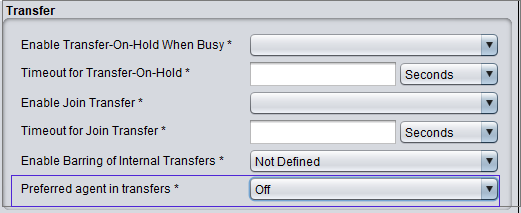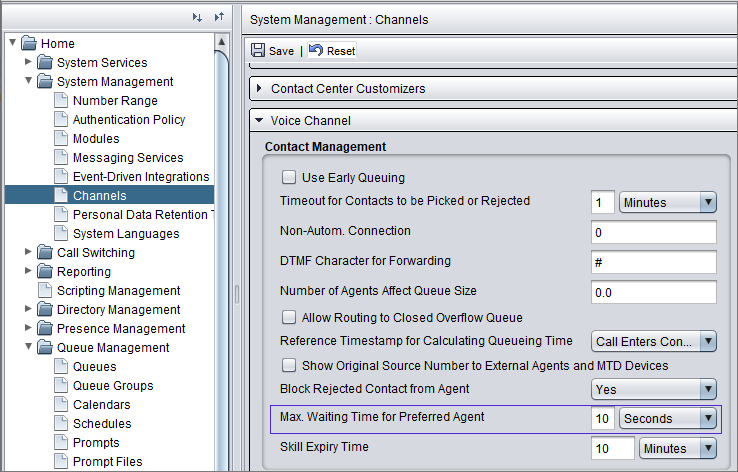Calls
By default, the preferred agent feature in all call transfers is used.
-
If you don't want to use preferred agent when an agent transfers a call, you can disable this option in
Setting Description Use preferred agent in transfers In addition to queue calls, this setting also affects direct calls, both incoming and outgoing and calls that are transferred using custom IVRs. By default, custom IVRs keep the preferred agent information. If you don't want to use preferred agent when a call is transferred, deselect this option.

-
Alternatively, you can define it on a per-queue basis in
Setting Description Preferred agent in transfers To change the default behavior for a queue, select the queue and choose Off. Note the following:
- Preferred agent is used according to the setting of the channel or destination queue.
- Even when this setting has the value Off and the transfer fails, the call is offered to the agent who transferred the call if the agent is available.

Deselecting preferred agent in transfers affects the scenario where the agent transferring the call to another queue is also serving in this queue. If the preferred agent in transfers is enabled for the destination queue, the call is offered to the agent who transferred the call. Note that even when the preferred agent in transfers isn't used and the transfer fails, the call is offered to the agent who transferred the call if the agent is available.
Defining waiting time
-
To define how long the system waits for the preferred agent, go to either
-

or
-

-
-
Define the waiting time.
Setting Description Max. Waiting Time for Preferred Agent The default value is 10 seconds.
For example, the preferred agent can be the last agent who answered the call. This is useful when a blind transfer fails and the call comes back to the queue. Then the system tries to reallocate the call to the same agent if the agent is potentially available:
Logged in and not logging out
Serving in the queue
No absence type profile active
No ongoing outbound campaign call
Not being offered another conversation (allocated but not yet accepted)
Have another connected conversation or the agent's status is Not Ready
If you want to route a call to the same agent who answered the call earlier, you need a silent IVR that searches the previous calls from the monitoring database. For more information, see Routing a conversation to the same agent.
EDI for defining preferred agent
-
To fetch the preferred agent name, use agent's extension phone number or chat address.
For more information about EDI, see Event-driven integrations.
-
To define how long the system waits for the preferred agent, go to either
-

or
-

-
-
Define the waiting time.
Setting Description Max. Waiting Time for Preferred Agent The default value is 10 seconds.
For example, the preferred agent can be the last agent who answered the call. This is useful when a blind transfer fails and the call comes back to the queue. Then the system tries to reallocate the call to the same agent if the agent is potentially available:
Logged in and not logging out
Serving in the queue
No absence type profile active
No ongoing outbound campaign call
Not being offered another conversation (allocated but not yet accepted)
Have another connected conversation or the agent's status is Not Ready
